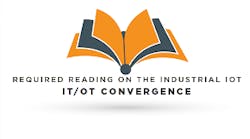Both OT and IT function within the enterprise to create output (goods and services), the report continues. To create output most efficiently, they need to work together. But in today’s enterprise, there’s a significant communication gap between OT and IT technologies. Each uses its own methods of connectivity, from the physical connectors and buses that data rides on, to the language each uses to convert bits and bytes into human readable and actionable information. Designed years ago, OT and IT technologies remain far apart today. During a recent keynote address at the Smart Industry 2015 conference, Richard Soley, executive director of the Industrial Internet Consortium, pointed out that ladder logic diagrams for PLCs used in discrete manufacturing in 1980 are very much like the ones used today. “Worse, though it’s got an Internet port on it now, it doesn’t connect to the IT infrastructure of the plant.” Why not?
Connectivity comes first
For decades, industrial products have been designed for long life. As a result of this long lifecycle, industrial devices installed today use varied physical communication layers, mostly proprietary to their industry. For example, you may have a variable frequency drive on a serial network, a proportional valve on FOUNDATION fieldbus, and a proximity sensor on DeviceNet, each a different physical network.
One of the first steps in connecting legacy industrial systems to the IoT is to provide some type of conversion from these application-specific physical buses to open, ubiquitous physical interfaces such as Ethernet and wireless. We’ll also need to aggregate smaller, simpler devices like non-networkable sensors or electric circuits into a networked gateway device, in order to transmit the sensor- level signals onto standard network interfaces and then into the primary Internet communications protocol: TCP/IP.
As a result of the purpose-built, application-specific nature of manufacturing and automation systems, the vast majority of devices found on the plant floor today use their own custom and often proprietary protocols to meet application requirements. While a custom protocol can be useful in a single given application, for example closed-loop process control, it creates yet another hurdle in accessing the data required to realize the benefits IoT offers.
In contrast to OT, IT enterprise networks use the same open standards and protocols found on the Internet. The Internet was founded on open communication standards like TCP/IP. Application-specific protocols are layered on top: HTTP/S, SMTP, SNMP, MQTT, and so on. The Internet uses programming languages like JavaScript, Java, and Python and presents information using technologies like HTML5 and CSS, all of which are open. To realize the promise of the Internet of Things, OT and IT technologies must converge, allowing connection and communication.
Perhaps in the short run, OT and IT can converge using solutions such as protocol gateways, OPC servers, and middleware. In the long run, however, OT/IT convergence will demand a flattened architecture and seamless communication between assets, using open, standards-based communication protocols and programming.
IoT at the edge
As of today, billions of “things” already are connected to the Internet, and their numbers are growing at a 30% clip. And all of these devices are generating data. Zettabytes of data. But is it useful data? And are modern networking technologies up to the task of moving that much data across the Internet?
The IoT is going to produce increasingly massive amounts of raw data from billions of sensors, actuators, and devices. How do we sort through the data to filter out what we need—to turn it into actionable information?
The answer lies in edge computing. The majority of IoT devices will be connected at the edge of the network, the place where OT and IT physically converge. The data that OT devices generate must be mined for what is useful to the enterprise and forwarded to cloud computing systems for big-data analysis; useless data must be discarded to reduce bandwidth requirements and noise. Unfortunately, most of today’s OT assets like individual sensors and machines don’t have the computing power required to process and filter the data they generate. More intelligent OT assets like PLCs tend to focus on single-task automation functions and have not been designed to share that manufacturing data with other systems. So the current IoT requires third-party systems that act as data brokers between OT and IT assets.
Give it a REST
The real vision of OT/IT convergence is for autonomous and direct communication—for assets, things, nodes, and servers to communicate directly with each other without the need for protocol gateways, OPC servers, and middleware. To enable direct asset-to-asset or thing-to-thing communication and truly bridge the OT/IT gap, manufacturers will push intelligence down directly into OT assets and enable those assets with IT communication capabilities, protocols, and languages.
We already see increased device capabilities as OT assets are beginning to be developed from the ground up with IoT applications in mind. Over time, we’ll see not only communication technologies but also increased intelligence, allowing assets on the edge to interpret and filter their own data into information, and then expose it via standard formats documented as web APIs.
To fully realize the benefits IoT has to offer, OT assets will need to be designed with web technologies built directly into them. These RESTful architectures leverage HTTP for interaction, SSL/TLS encryption and authentication for data security, and JSON for data format. They’re available today, and destined for an Internet of Things application near you.


